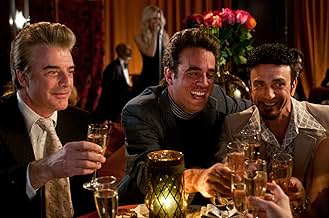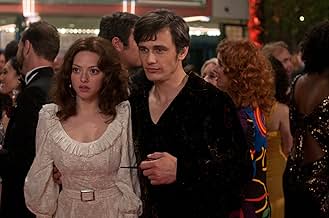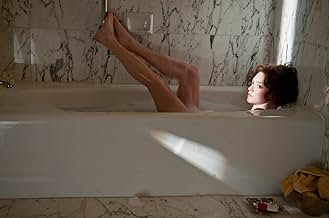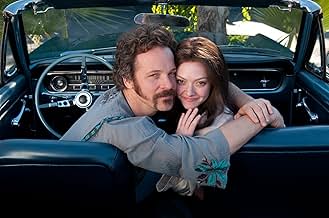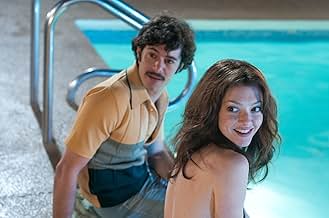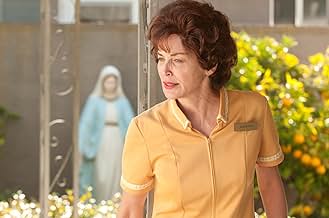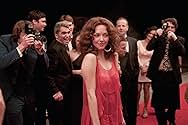L'histoire de Linda Lovelace, qui est utilisée et abusée par l'industrie du porno sur ordre de son mari coercitif avant de prendre le contrôle de sa vie.L'histoire de Linda Lovelace, qui est utilisée et abusée par l'industrie du porno sur ordre de son mari coercitif avant de prendre le contrôle de sa vie.L'histoire de Linda Lovelace, qui est utilisée et abusée par l'industrie du porno sur ordre de son mari coercitif avant de prendre le contrôle de sa vie.
- Prix
- 1 victoire et 3 nominations au total
- Sammy Davis Jr.
- (as Ronald Pritchard)
Histoire
Le saviez-vous
- AnecdotesIn an interview, Amanda Seyfried talked about why she had no issue with being naked in this and other films. "I don't know why I'm comfortable. Nudity: whatever! Sex: we all do it. There's a time and a place to be naked (laughs). There's no part in this movie that makes me think, 'Oh, wow, she's naked.' She's a porn star! We simulated some scenes but there's no graphic content in this movie, at all. I mean the graphic stuff is when he's raping me on my wedding night. You see my skirt go up over my head when I'm being gang raped, but it's like so perfectly done. 'Chloe' is so graphic. And this is not...(Peter Sarsgaard and I) are not shy about our private parts. We also weren't walking around with our genitals out; our bottom half genitals. That might have been a little strange for me. I don't really have any interest in people seeing my vagina. It's just a personal thing. I don't mind seeing other people's vaginas. I guess I'm just insecure in that way. Peter, same thing. He was always covered up in that way. I think it's just our mutual understanding of we needed to be naked a lot of points in the movie and it wasn't a big deal. It's like a costume. I don't know why I feel comfortable. To be honest, when I was younger, I was terrified of sex. I don't know what happened over the years. I now have an appreciation for it, for people who don't put so much heaviness on it. I also don't understand why it's censored in movies."
- GaffesIn a scene set in 1970, two characters discuss La filière française (1971), which was released in 1971.
- Citations
Linda: You know I spent exactly seventeen days in the pornography industry and somehow these seventeen days are suppose to define who I am for the rest of my life, but I hope that people can see me for who I really am. I mean Linda Lovelace was a fictitious character. My name is Linda Marchiano. I can finally be myself. I'm a mother and a wife and that is where I found my joy.
- Bandes originalesI've Got to Use My Imagination
Written by Gerry Goffin and Barry Goldberg
Performed by Gladys Knight & The Pips
Copyright 1973 SCREEN GEMS-EMI MUSIC (BMI)
Courtesy of Buddah
by arrangements with Sony Music Entertainment
Poor and mediocre biopics either become blatantly overwhelmed by a life's complications, or ignore them altogether. Unfortunately, "Lovelace" chooses to ignore, and consequently misses greatness.
The woman who was born Linda Susan Boreman, and would later be better known by her stage name, Linda Lovelace, lived a very complicated, and devastatingly sad, life. This film centers on the real life Lovelace's claims of being used and abused by her first husband, Chuck Traynor, and being browbeaten into the pornography industry.
Lovelace's allegations of spousal abuse have been disputed by some, and supported by others who knew her personally, but that's beside the point. The film was right in basing its narrative solely on Lovelace's side of the story, not getting bogged down by antipathetic discrepancies. Still, there were crucial parts of her life the movie should not have left out.
For instance, "Lovelace" strongly implies that "Deep Throat" was Lovelace's first pornographic film (untrue) and her last (also untrue). It doesn't mention a stag film in which she engages in bestiality with a dog.
In one of her four books (yes, she wrote four books), she claimed that Traynor forced her to act in such movies, which would have made a good case in this movie for how controlling Traynor was. After all, having sex with a dog, especially on camera, is not an action in which most would engage willingly.
I could go on about relevant moments of the real Lovelace's life that this movie chose to ignore. However, the primary faults of "Lovelace" lie not in what they left out, but in a questionable storytelling structure where the filmmakers obviously tried to be too clever in their narrative.
Basically, the first half of the film chronicles a 21-year-old, naive Linda Boreman (Amanda Seyfried) who lives with her strict, Catholic parents (Robert Patrick and a shockingly deglamorized, unrecognizable Sharon Stone) in Florida. A charismatic, 27-year-old Chuck Traynor (Peter Sarsgaard) spots Linda at a rollerskating rink and begins dating her.
While Traynor claims to own a bar and restaurant, young Linda doesn't realize he dabbles in prostitution until after they are married, and she bails him out of jail. Eventually, Traynor coerces her into performing sexual acts on complete strangers for money before taking her to audition for pornographic movies.
From here, the film chronicles the making of the notorious "Deep Throat", the rise of Linda Lovelace, and does more than hint at the unexpected cultural impact the film creates.
Halfway through, the film makes the mistake of jumping ahead six years later (I guess circa 1980), and showing a visibly disheveled Linda taking a lie detector test administered by a publisher (Eric Roberts) in order to assess the validity of her marital abuse claims in her new autobiography, "Ordeal". The film then jumps back 8 or 9 years to show many of the same scenes over again, except adding footage at the end of each scene actually showing Traynor physically and sexually abusing Linda.
Why go back and show these scenes? The lie detector scene would have made a good narrative framework, especially since you see Amanda Seyfried look so shockingly worn down. This is not the same doe- eyed, blonde hottie from "Mamma Mia" (2008), or at least it doesn't look like her.
The point is, though, that going back and retreading all the scenes feels like a waste of time. Considering the film's running time of 93 minutes, there is no excuse for retread, especially considering Sarah Jessica Parker's well-publicized cameo as Gloria Steinem was cut out of the film altogether.
However, casting was the film's main strength, which I initially thought would be its weakness. I had my doubts about Seyfried portraying Lovelace, considering that Seyfried is exceptionally gorgeous, and the real Linda Lovelace was (Is there any way to say this nicely?) not even close. Listing actresses in this review who bear a stronger resemblance to the doomed porn starlet would probably be insulting to them.
While Seyfried donned a shaggy brunette hairstyle and freckles to deglamorize herself, she still looked a lot prettier than Lovelace on her best day. Scenes such as low-level mobster Butchie Periano (Bobby Cannavale) arguing that she is not attractive enough for the porno he is financing appear consequently more dubious.
Still, Seyfried did well with what she was given. Her best scenes include the lie-detection test, a surprisingly touching moment with an unexpectedly cordial publicity photographer (Wes Bentley), and her begging her emotionally cold mother for asylum from her abusive husband. Another scene where she is raped by five men at Traynor's behest shows little, but is still hard to watch.
While Peter Sarsgaard is effectively charismatic as Chuck Traynor, he wasn't convincing enough during the abuse scenes. Every time he threw Seyfried around, his face looked as though he would apologize to her right after the directors yelled "Cut!".
Sharon Stone, as Dorothy Boreman, had the movie's best performance, and not just because she is indistinguishable from her more glamorous roles. The scene where she does anything but console a visibly frightened Seyfried makes her eerily believable, and surprisingly multifaceted.
While the performances were well done, and "Lovelace" successfully shied away from exploitation, it suffered from fractured storytelling, awkward editing, and the vague epilogue implying that Lovelace's life only improved before her untimely death in 2002 in a car crash. If you watch the insightful documentary "Inside Deep Throat" (2005), or read Joe Bob Briggs' excellent, astute retrospective on her life (http://old.nationalreview.com/comment/comment-briggs042502.asp), you'll get a far more accurate, and grimmer, account of her life after pornography. It's sad, dismal, and, as "Lovelace" proves, a story Hollywood still does not want to tell.
- D_Burke
- 10 août 2013
- Lien permanent
Meilleurs choix
- How long is Lovelace?Propulsé par Alexa
Détails
- Date de sortie
- Pays d’origine
- Langue
- Aussi connu sous le nom de
- Лавлейс
- Lieux de tournage
- Alex Theatre - 216 North Brand Boulevard, Glendale, Californie, États-Unis(Deep Throat private screening)
- sociétés de production
- Consultez plus de crédits d'entreprise sur IMDbPro
Box-office
- Budget
- 10 000 000 $ US (estimation)
- Brut – États-Unis et Canada
- 356 582 $ US
- Fin de semaine d'ouverture – États-Unis et Canada
- 184 536 $ US
- 11 août 2013
- Brut – à l'échelle mondiale
- 1 585 583 $ US
- Durée1 heure 33 minutes
- Couleur
- Mixage
- Rapport de forme
- 1.85 : 1
Contribuer à cette page



